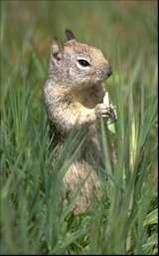Squirrels eat a variety of fresh greens as well as seeds and dried nuts. In spring, ground squirrels prefer greens over seeds and nuts. Once the natural grasses begin to dry and wither, squirrels will actively forage for seeds.
As foragers, squirrels are well-adapted to find sparsely dispersed food, one seed at a time. Once squirrels have had their fill, they will
collect food in their cheek pouches and take it back to the nest to form a cache for later use. Squirrels tend to forage close to their burrow, although they will travel for desirable foods.
How Biology relates to control:
The California ground squirrel prefers to forage for food in the early morning or late afternoon/early evening to avoid the day's heat. In some crop situations, especially nut crops, squirrels may prefer the crop to the point where they will not eat any bait. If the squirrel won't eat the bait, the poison bait method will not work. In this case, an alternative control approach may be necessary (trapping or fumigation).
Understanding these feeding preferences is extremely important when using baits since they are seed based. Also, in irrigated crops or landscape areas, squirrel feeding preferences are influenced by what food is available. For example, the natural vegetation may be dry in early summer and squirrels are actively foraging for seed. If newly sprouted crops are available however, the squirrels may take them with great delight.
The calendar of ground squirrel diet, activity and control measures is adapted from the Best Management Practices for California Ground Squirrel Control website at http://groups.ucanr.org/GSBMP/. Calendar dates are merely an estimation of time; actual time frames may vary according to the weather. The calendar may be laminated for use in planning and training for your operation.
